By Visualizing Palestine.
For decades, Palestinians have been calling for an end to Israeli settler colonialism, apartheid, and military occupation. Like any other community, Palestinians will not accept oppression in perpetuity. As U.S. representative Rashida Tlaib captured powerfully in her statement, a just future “must include lifting the blockade, ending the occupation, and dismantling the apartheid system that creates the suffocating, dehumanizing conditions that can lead to resistance. The failure to recognize the violent reality of living under siege, occupation, and apartheid makes no one safer.” Decolonization is the only path toward collective liberation, and it will take all of us to turn the tide of oppression toward justice.
In the early morning hours of Saturday, October 6, Palestinian resistance fighters broke through Israel’s 16-year air, land, and sea blockade on Gaza’s 2.3 million residents, taking control of several Israeli military posts and towns in the Gaza vicinity. So far, according to the Al-Jazeera tracker, at least 570 Palestinians have been killed, and more than 2,700 have been wounded. At the same time, over 800 Israelis have been killed, and more than 2,000 have been wounded.
While the scale and coordination of this event is unprecedented, commentators have been observing a resurgence and evolution in Palestinian armed resistance in response to escalating Israeli killings, invasions, home demolitions, land confiscations, and settler violence. Intensified oppression has been particularly evident in the last two years, after 75 years of ongoing Israeli violence.
We do not know what will happen over the next few days, but we are paying close attention to the continued Israeli assault on Gaza and the rush by U.S. and EU officials to support the Israeli military, which will only cause more loss of life and the continuation of a devastating status quo.
On Saturday, Israeli Prime Minister Benjamin Netanyahu called on the residents of Gaza to “get out” of Gaza, knowing full well that they have nowhere to go. Since then, Israel has cut off electricity in Gaza, barred the import of food and fuel, and bombed the homes of thousands of civilians.
Right now, Palestinians and Palestinian solidarity movement activists are focused on putting the events of the last few days in context as the product of a system of violence. Here are a few Visualizing Palestine resources you can use to join this effort:
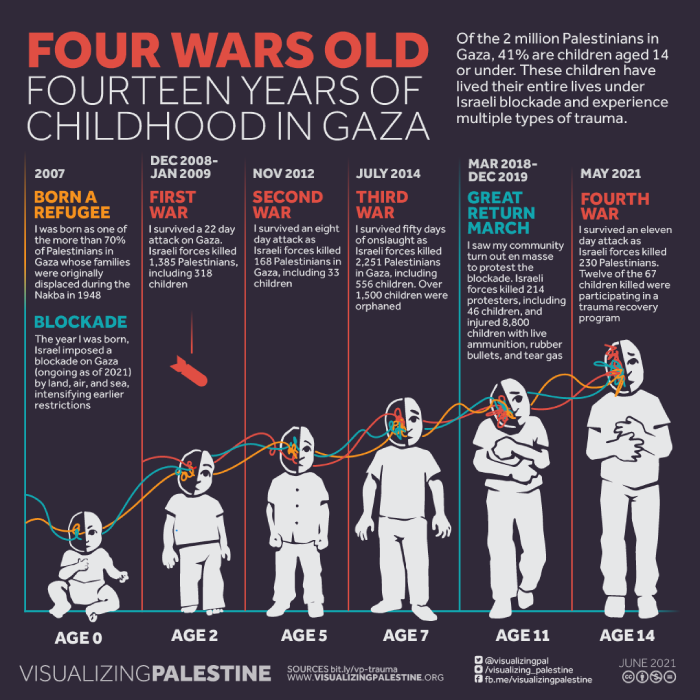
Four Wars Old
At least 90 Palestinian children have been killed by Israel’s assault on Gaza so far. Use this visual to tell the story of Palestinian children in Gaza, who have experienced multiple assaults and multiple types of trauma since 2007, leading to a widespread mental health crisis among youth.
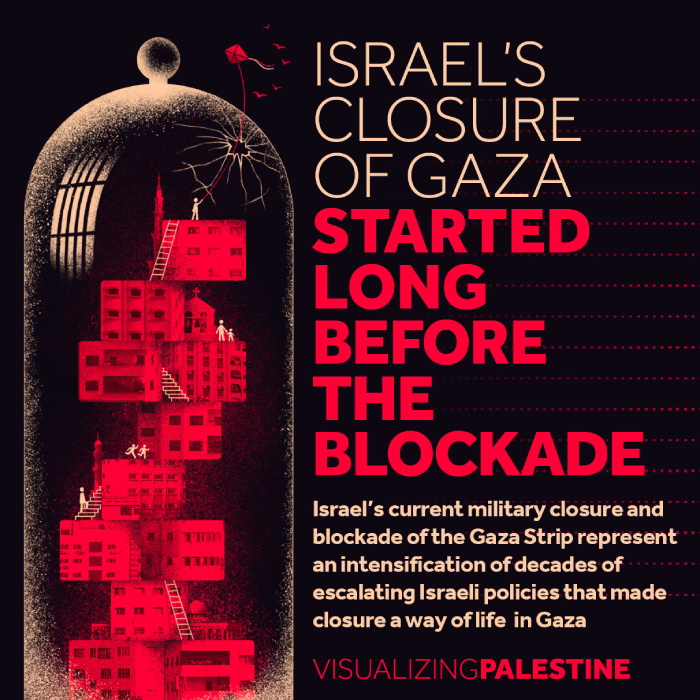
Israel’s Closure of Gaza Started Long Before the Blockade
The 16-year land, air, and sea blockade of Gaza represents an intensification of decades of escalating Israeli policies that made closure a way of life in Gaza. Use this visual to tell the story of Israel’s forced isolation of Palestinian residents of Gaza from Palestinians in other parts of historic Palestine.

Short Walk Home Long Walk To Freedom
From 2018-2019, Palestinians in Gaza engaged in mass civil resistance, calling for an end to Israel’s blockade and the realization of their right to return. Israel’s response was to open fire on protesters, massacring hundreds and wounding thousands. Use this visual to tell the story of Israel’s repression of Palestinian civil resistance in Gaza.
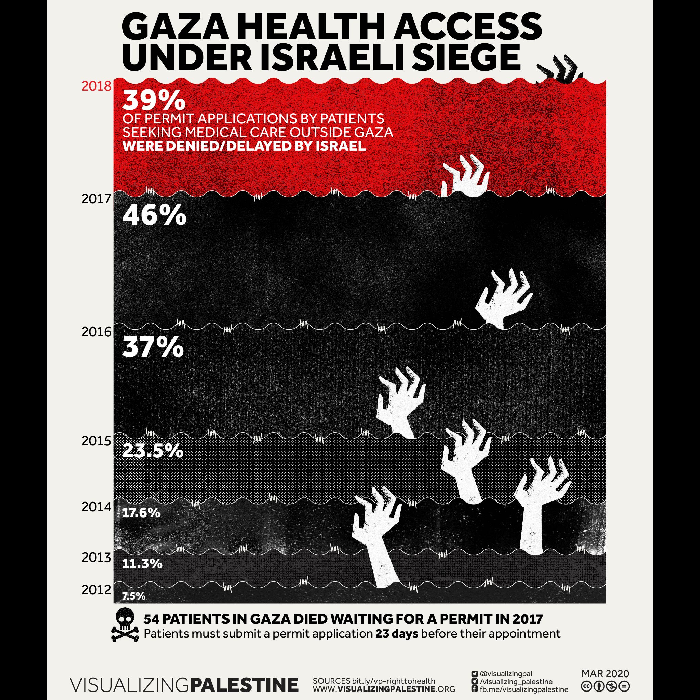
Gaza Health Access Under Israeli Siege
Under Israeli blockade, Gaza hospitals experience a chronic shortage in essential medicines and equipment. Patients are forced to apply for a permit to seek care outside Gaza, and there is a high rate of denial of these permits by Israeli authorities. Numerous people have died awaiting treatment. Use this visual to share the dire health conditions that Palestinians navigate on a daily basis under blockade.
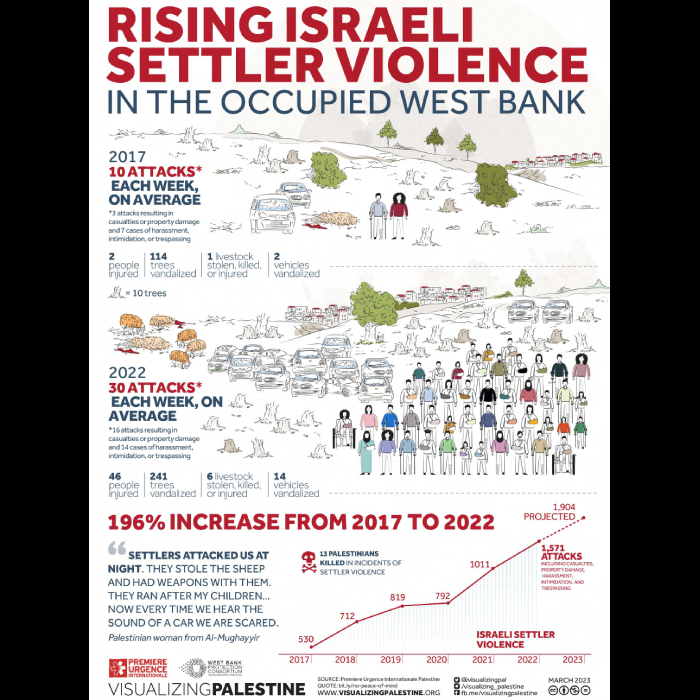
Rising Israeli Settler Violence
There was a 196% increase in acts of Israeli settler violence from 2017-2022, with an even more alarming projection of the rise of settler violence in 2023. Use this visual to tell the story of long-running impunity for escalating human rights violations against Palestinians.
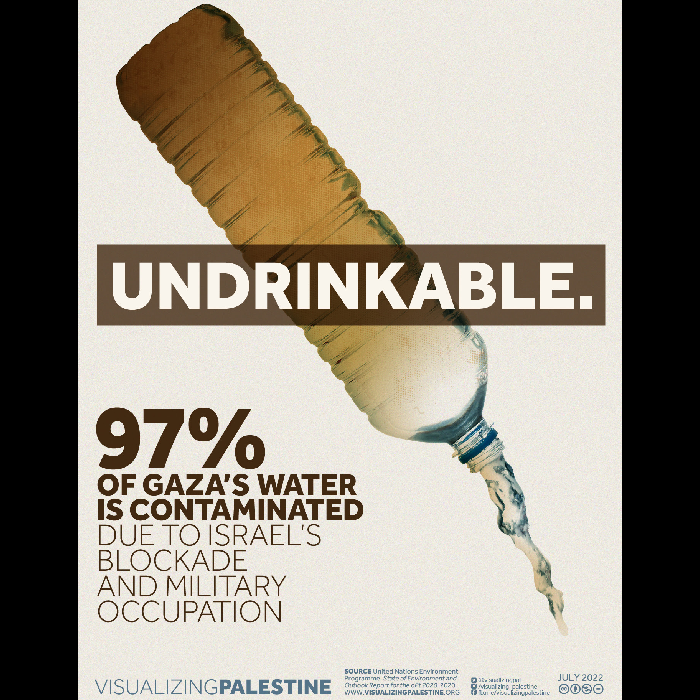
Undrinkable
Only 3% of Gaza’s water is fit for human consumption. Use this visual to tell the story of how Israel’s military blockade on Gaza and recurring bombardments have made conditions in Gaza incompatible with a life of dignity.
Source: Visulaizing Palestine. 10 Oct 2023